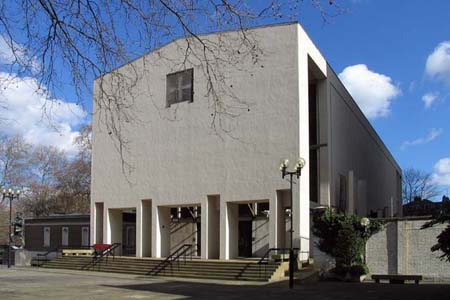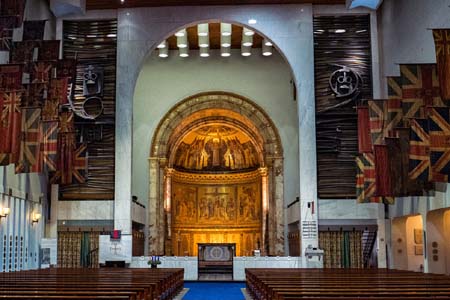| |
 |
 |
 |
| Comment on this report, or find other reports. |
 |
| Our Mystery Worshippers are volunteers who warm church pews for us around the world. If you'd like to become a Mystery Worshipper, start here. |
 |
| Find out how to reproduce this report in your church magazine or website. |
|
|
| 3087: Royal Military Chapel (Guards Chapel), St James Park, London |
 |

Photo:
© John Salmon and used under license
|
 |
Mystery Worshipper: Cool Dude.
The church: Royal Military Chapel (Guards Chapel), St James Park, London.
Denomination: Church of England, Diocese of London.
The building: Set back from Birdcage Walk, a few moments stroll (or march) from Buckingham Palace, the Guards Chapel is not obviously a chapel. It is a large rectangle with few windows. The previous 1879 chapel in the style of an early Christian basilica (a style favoured for so many garrison chapels) was all but demolished by a World War II bomb that killed 120 people inside at the time. This survives as a fragment – the apse around the altar, restored and resplendent in mosaic. The new chapel is by architect Bruce George, a champion of the Scandinavian functionalist style and who, as a partner in the firm of George, Trew and Dunn, specialised in designing hospitals. The inside is finished with white marble and is mostly lit from roof lights, a slightly chilly effect that is saved from unfriendliness by a large collection of battle colours, military memorials, and salvaged fittings from the bombed chapel – the font and some stained glass, for example. It is very lofty and grand in a reserved way. The battle colours date from the 17th century and therefore include the pre-1801 Union Flag (without St Patrick's cross).
The church: This is the only remaining military chapel in London and, as such, is the spiritual home of the Household Division in their ceremonial and combat roles. Whether there is a church community here I am curious to know, although the website of the British Army calls it "a living church, prayed in daily" and says that the congregation is comprised of "past and present members of the Household Division, local people and visitors." Their Sunday services alternate between choral communion and matins. Concerts are regularly put on by a variety of military bands. The chapel is open to all free of charge throughout the week.
The neighbourhood: Birdcage Walk has had a rather colourful history. It was named after the Royal Menagerie and Aviary established by King James I and expanded by King Charles II in 1660. At first, the only persons permitted to ride in carriages on it were the British Royal Family and the Hereditary Grand Falconer; all others had to traverse it on foot. But after it was opened to the public in 1828, it gained a reputation as a place where "gentlemen meet gentlemen." Aside from the Guards Chapel, the Wellington Barracks are located there today, which appear to be the working (and living?) quarters for a significant number of Guardsmen. The Ministry of Justice is next door and even on a Sunday there are plenty of tourists. As I arrived, Guardsmen in bearskins were marching to (or was it from?) the Changing of the Guard at the Palace.
The cast: The chaplain – no name was given, but the chapel website identifies him as the Revd SJH Dunwoody CF.
The date & time: All Saints Sunday, 30 October 2016, 11.00am.
What was the name of the service?
Choral Holy Communion.
How full was the building?
About 60 people in a building that I guess could seat 500. The congregation were mostly 50+ and conservatively dressed. There were three Guardsmen in their striking dress uniforms, each with a role to play. I wondered who the congregation were – regulars or those simply curious and, like me, gratifying curiosity after having walked past this enigmatic building for decades.
Did anyone welcome you personally?
A Guardsman resplendent in scarlet dress uniform politely bade me good morning and gave me the service sheets. Outside the door, Guardsmen wore a different uniform: fatigues and bearing machine guns – a reminder to visitors that this is a working barracks.
Was your pew comfortable?
The pew had a cushion and passed muster.
How would you describe the pre-service
atmosphere?
The congregation gathered quietly. Mellow string music set the tone and it took a few moments to realise this was live, since the musicians were hidden behind a screen in a gallery. The service sheet announced them as the Countess of Wessex's String Orchestra under the direction of Staff Sergeant Claire Lawrence. They are a fine quartet.
What were the exact opening words of the
service?
"Good morning."
What books did the congregation use during the
service?
A service booklet with most of the service, plus a weekly sheet with music details and notices. Well-worn copies of the Book of Common Prayer were in the pews but not used. We sang hymns from Hymns Ancient and Modern.
What musical instruments were played?
The string orchestra, reinforced by the organ for hymns.
Did anything distract you?
There were brass cups on the floor and rings on the backs of each pew seat – right across the chapel. What were they for? I wondered. Swords for officers in dress uniform or perhaps colours? The chapel must be transformed when they are in use, if so.

Was the worship stiff-upper-lip, happy clappy, or
what?
Straight up established Anglican service but with a sung Catholic mass slotted in. Today it was the Missa O Quam Gloriosum of Tomás Luis de Victoria, one of my favourites. It was sung very well in the English style by the chapel's own professional choir. The mix of liturgy mostly worked. The Kyrie of the mass was sung from the west before the clergy and choir entered in procession.
Exactly how long was the sermon?
8 minutes.
On a scale of 1-10, how good was the preacher?
6 – A clear exposition delivered well, but nothing to write home about.
In a nutshell, what was the sermon
about?
Saints – it was All Saints Sunday. The chaplain sketched the development of the concept of sainthood from the "super Christians" of the earliest church to the fourth century introduction of canonisation. He mentioned some of his favourite saints and brought sainthood up-to-date by ending, "Perhaps the person sitting next you right now is a saint in the eyes of God."
Which part of the service was like being in
heaven?
The Victoria mass setting.
And which part was like being in... er... the other place?
The peace was announced at the usual place but nobody moved and the service rapidly moved on. Not even the briefest handshake. Though I am no fan of the comprehensive peace that brings things to a halt, not having one at all seemed very stiff upper lip. An acknowledgement of the other worshippers would have brought us together a little.
What happened when you hung around after the service looking lost?
There was a reception line to meet the chaplain. It moved slowly. Tea was available in the narthex. We were invited to linger for tea, though most didn't. Me neither, as I was late for lunch.
How would you describe the after-service
coffee?
Can't say.
How would you feel about making this church your regular (where 10 = ecstatic, 0 = terminal)?
5 – Such a Royal institution did not have the feel of a chapel with a regular congregation. But I may well return some day for the fine music.
Did the service make you feel glad to be a
Christian?
Yes.
What one thing will you remember about all this in seven days' time?
The scarlet uniforms. |
|
|
 |
 |
 |
| We rely on voluntary donations to stay online. If you're a regular visitor to Ship of Fools, please consider supporting us. |
 |
 |
 |
| The Mystery Pilgrim |
 |
| One of our most seasoned reporters makes the Camino pilgrimage to Santiago de Compostela in Spain. Read here. |
 |
 |
 |
| London churches |
 |
| Read reports from 70 London churches, visited by a small army of Mystery Worshippers on one single Sunday. Read here. |
| |
|
|
|
|


